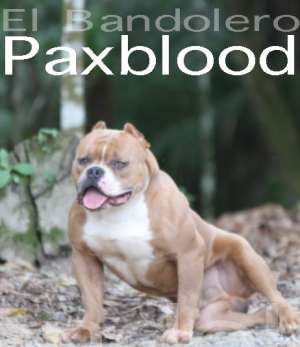Located in São Paulo brasil, Petclube has established a recognized name breeding American Bullies . Petclube love Original  Gottyline, owner of Pax Daxline Gottyline, the first tricolored dog registered with IPC as Gottyline Petclube history.
Gottyline, owner of Pax Daxline Gottyline, the first tricolored dog registered with IPC as Gottyline Petclube history.
PAX is the ideal extreme Pocket American Bully.
If you understood this article then you know the tri color gene is recessive, which means you need both parents to be carriers in order to produce tri color american bully pitbulls.
Due to PAX’s popularity as a stud and and ability as a producer of quality Bullies, he has already had a huge impact changing the image of the American Bully. There has never been an American Bully like PAX.
If you are looking for an exceptional Bully in every way, there is none better than the new PaxBLOOD Bullies. If you want the best, come to the Source! PETCLUBE PAXBLOOD the Original Gottyline.
Bullies are very popular dogs as a pet for anyone who wants to own one. Selecting a Bullies from a bloodline which has a high-quality pedigree is one key requirement for anyone wanting to own such a dog. There are many kennels that produces such high-quality Bullies, but the dogs of the American Bully Gottiline are one of the most popular.
Tricolor Gene Paxblood
Petclube with Paxblood Amichetti Bullies is proud to be one of the top producers of blue tri color pitbull bully. We often get calls asking about how we get the tri color pitbull puppies we have for sale. Here is an explanation of how the blue tri, fawn tri, black tri, chocolate tri, champagne tri (purple tri), or any tri color pitbull bully is produced.
The tan point pattern is caused by a recessive gene on the Agouti series gene locus, the following are the alleles (variations) that are definitely known to occur in the American Pit Bull Terrier and the american bully gottiline. There are also a couple of other genes on this same locus, but they are most likely not present in this breed, so we will ignore them in this article to try and keep things simple.
Agouti locus alleles present in the APBT and AB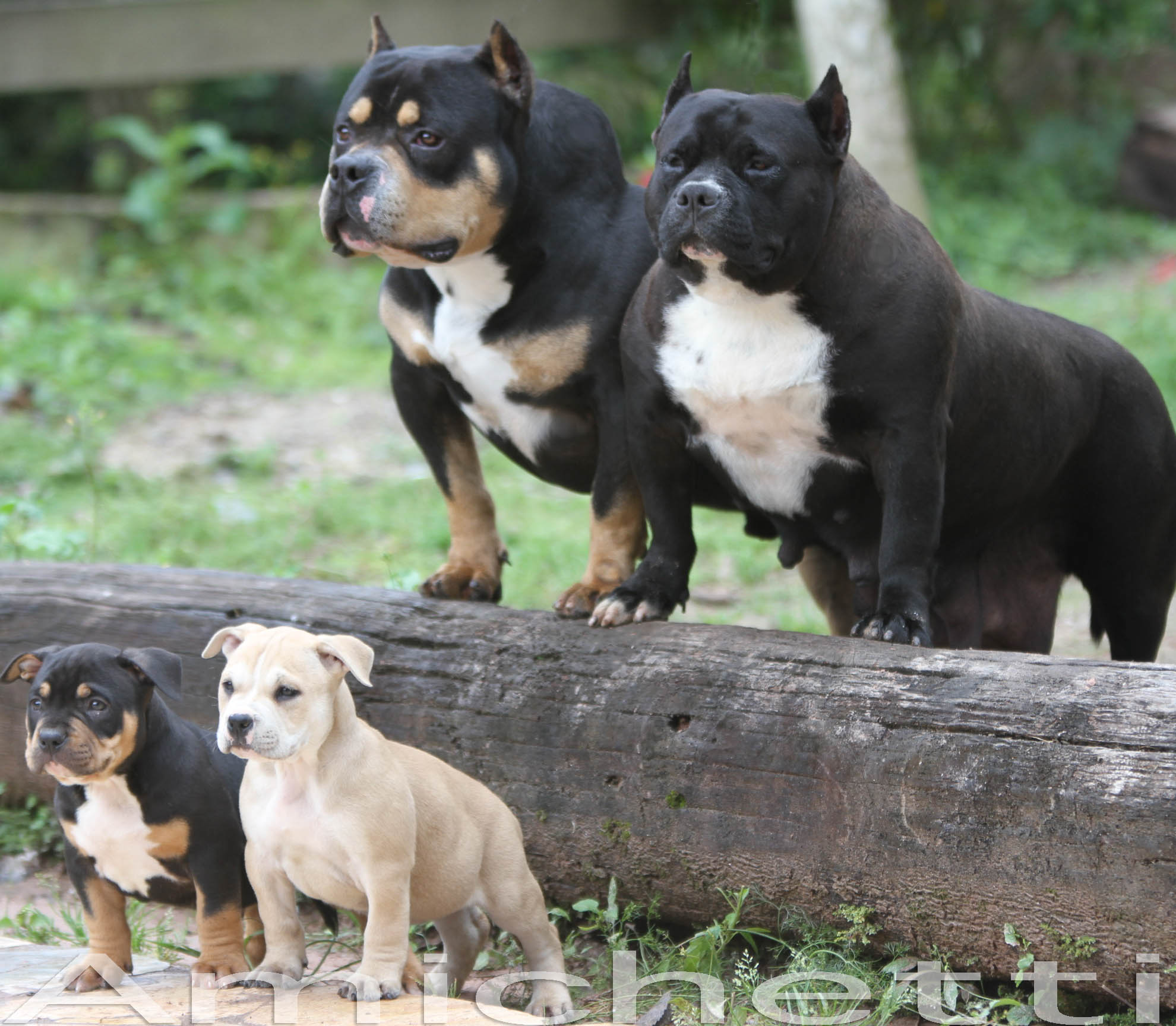 A Dominant Black: produces a solid color (ie: black, chocolate or blue)
A Dominant Black: produces a solid color (ie: black, chocolate or blue)
ay Dominant Yellow – Produces reds and buckskins
at Tan-Point (recessive)- produces solid color with tan 'points'
A dog needs to inherit two copies of the tan-point gene to be a black & tan. If a pup inherits one copy of the gene and one copy of the dominant yellow gene, which causes a red or buckskin coloration, then the dog will be red or buckskin, not black and tan. If the dog inherits one copy of the tan-point gene and one of the dominant black gene, the result will be a solid black dog. because of the recessive nature of the tan-point gene, it can actually remain hidden in the gene pool for many generations without expressing itself. In the case of our breed (where this is not a common color) this is what often happens, but it is important to realize that when the tan-point pattern does pop up it is not some new color mutation that appeared out of nowhere, but rather the manifestation of a gene that has been present in this breed all throughout the known history of the American Pit Bull Terrier. Though it is impossible to say for sure where the coloration originated, our best guess would be that it came from some sort of terrier blood that was introduced many, many years ago, probably during the early formation of the breed in the British Isles.
Actually, part of the reason the color is uncommon is that there has been a distinct prejudice against it by many people, either because they feel it is not a typical Pit Bull color, or even actually thought it was the result of a mixed breeding. The latter reason shows an ignorance of basic genetic principles, because the gene is recessive, there is no way you could breed a Rottweiler or a Doberman or Manchester Terrier to a Pit Bull and get puppies with the tan-point markings unless the Pit Bull was carrying the tan- point gene too. If in fact the black and tan color was not present in the APBT gene pool, you would have to breed to a dog of another tan-point breed, and then breed two offspring from such a breeding back together to get black & tan dogs, in the first generation you would get no tan-pointed offspring.
The tan point gene does not actually create a black & tan animal, the gene itself does not produce any color but rather a pattern of a solid color with light-colored 'points'. These 'points' always appear in specific places but the actual size and distribution of them is somewhat variable. The exact coloration that is produced by the tan-point gene is dependent on the color genes present at other loci, for instance if the pigmentation is black, the result will be a black & tan, but if the dog's pigmentation is chocolate or blue then the pattern would produce a chocolate & tan or a blue & tan, respectively.
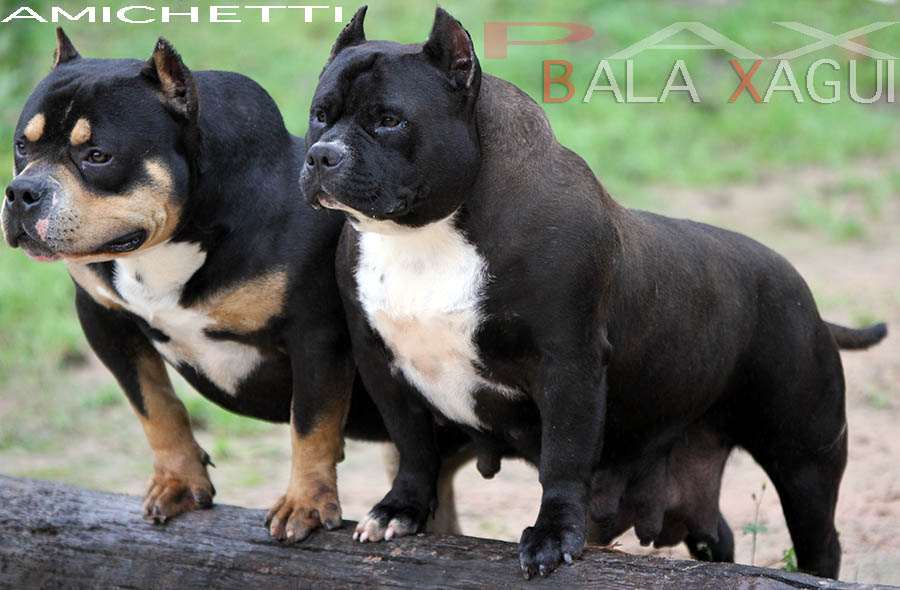 Also don't get fool into the hype of the tri color gene being stronger because several generations were tri colors. Having it in several generations doesn't mean anything when it's a recessive gene. It doesn't matter if every single dog in the pedigree were tri color pitbulls, it is still a recessive gene which means other colors will dominate first. So it comes down to matching two parents that carry the gene not generations of it to produce tri color pitbulls.
Also don't get fool into the hype of the tri color gene being stronger because several generations were tri colors. Having it in several generations doesn't mean anything when it's a recessive gene. It doesn't matter if every single dog in the pedigree were tri color pitbulls, it is still a recessive gene which means other colors will dominate first. So it comes down to matching two parents that carry the gene not generations of it to produce tri color pitbulls.
Thanks for taking the time to learn about tri color pitbulls
This applies to the American Bully even though the American Bully stems off from the pit bull but has also been influenced by the infusion of several different types of bulldog breeds according to both the UKC , IPC Registry & ABKC.
There are also a couple of other genes on this same locus, but they are most likely not present in this breed, so we will ignore them in this article to try and keep things simple.
Agouti locus alleles present in the APBT and Bullies
A Dominant Black: produces a solid color (ie: black, chocolate or blue)
ay Dominant Yellow – Produces reds and buckskins
at Tan-Point (recessive)- produces solid color with tan 'points'
A dog needs to inherit two copies of the tan-point gene to be a tri colored. If a pup inherits one copy of the gene and one copy of the dominant yellow gene, which causes a red or buckskin coloration, then the dog will be red or buckskin, not tri colored.
If the dog inherits one copy of the tan-point gene and one of the dominant black, blue, or tan gene, the result will be a solid black blue, tan dog. because of the recessive nature of the tan-point gene, it can actually remain hidden in the gene pool for many generations without expressing itself.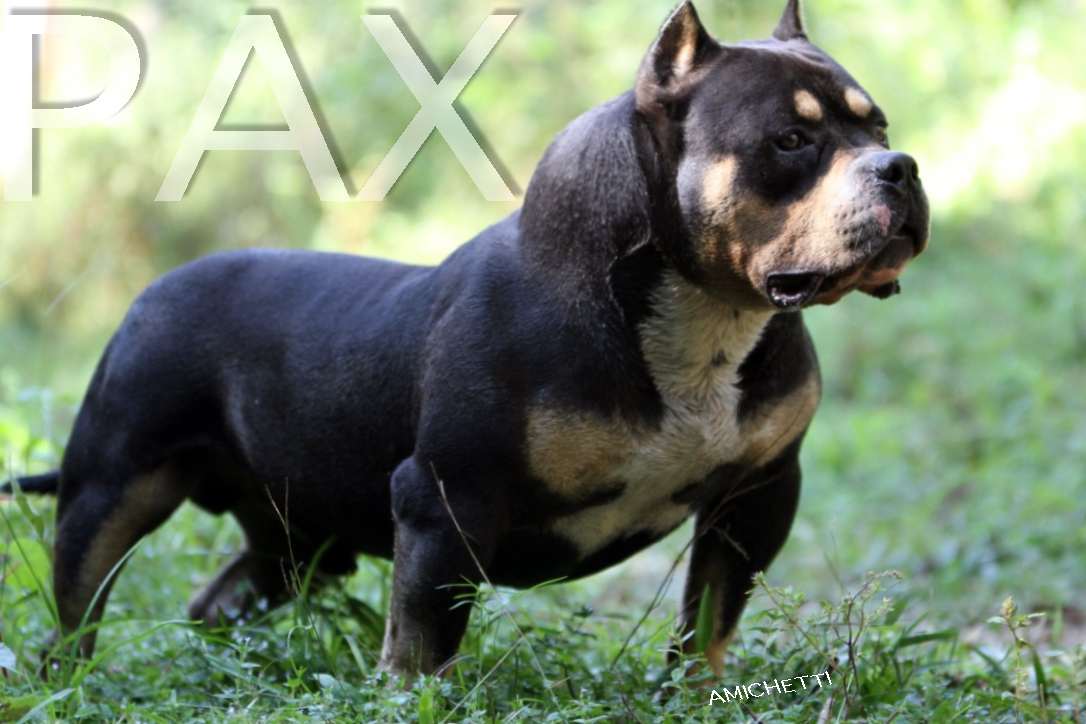 In the case of our breed (where this is not a common color) this is what often happens, but it is important to realize that when the tan-point pattern does pop up it is not some new color mutation that appeared out of nowhere, but rather the manifestation of a gene that has been present in this breed all throughout the known history of the American Pit Bull Terrier.
In the case of our breed (where this is not a common color) this is what often happens, but it is important to realize that when the tan-point pattern does pop up it is not some new color mutation that appeared out of nowhere, but rather the manifestation of a gene that has been present in this breed all throughout the known history of the American Pit Bull Terrier.
Though it is impossible to say for sure where the coloration originated, our best guess would be that it came from some sort of terrier blood that was introduced many, many years ago, probably during the early formation of the breed in the British Isles. Actually, part of the reason the color is uncommon is that there has been a distinct prejudice against it by many people, either because they feel it is not a typical Pit Bull color, or even actually thought it was the result of a mixed breeding.
The latter reason shows an ignorance of basic genetic principles, because the gene is recessive, there is no way you could breed a Rottweiler or a Doberman or Manchester Terrier to a Pit Bull and get puppies with the tan-point markings unless the Pit Bull was carrying the tan- point gene too.
If in fact the black and tan color was not present in the APBT gene pool, you would have to breed to a dog of another tan-point breed, and then breed two offspring from such a breeding back together to get black & tan dogs, in the first generation you would get no tan-pointed offspring.
The tan point gene does not actually create a black & tan animal, the gene itself does not produce any color but rather a pattern of a solid color with light-colored 'points'. These 'points' always appear in specific places but the actual size and distribution of them is somewhat variable.
The exact coloration that is produced by the tan-point gene is dependent on the color genes present at other loci, for instance if the pigmentation is black, the result will be a black & tan, but if the dog's pigmentation is chocolate or blue then the pattern would produce a chocolate & tan or a blue & tan, respectively.
You don't have to understand the fancy words (I don't understand or care what an allele is) but you now know the tri color gene is recessive, which means you need both parents to be carriers in order to produce tri color pitbulls.
Also don't get fooled into the hype of the tri color gene being stronger because several generations were tri colors. Having it in several generations doesn't mean anything when it's a recessive gene.
It doesn't matter if every single dog in the pedigree were tri color pit bulls or American Bullies, it is still a recessive gene which means other colors will dominate first. So it comes down to matching two parents that carry the gene not generations for it to produce tri color pit bulls.
Also, breed for temperament, health, functionality and structure. Not for color. Do this and you'll be proud of what you produce. Hope this article was helpful.
American Bullies Gottiline and Their Popularity
Dogs from the American Bully Gottiline bloodline are one of the most popular dogs in the United States and like other popular Bully bloodline they are in demand. However these dogs are also popular outside the United States. Other countries like Japan, Canada, China and the Philippines have dog owners who have taken a liking to the American Bully Gottiline dogs. It is quite remarkable that Gottiline dogs have such good popularity to most if not all countries. This dog’s loyal, friendly and faithful temperament is one of the things that make it so popular locally and globally.
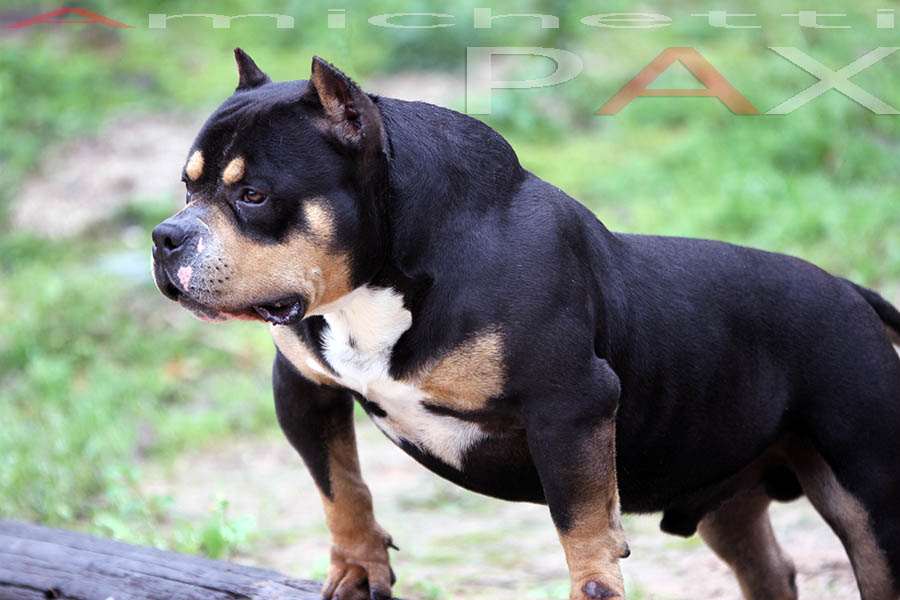
American Bully Gottiline
How the American Bully Gottiline Bloodline Was Founded?
West Side kennel’s owner Richard Barajas was the one who founded the Gottiline bloodline. In 1997 he bought a dog from Tony Moore (who owns Grey Line kennels) named “The Notorious Juan Gotty” at the amount of 1,300 dollars. It was the passing of Richard’s original sire named “Raider” that prompted him to buy Gotty who was 7 weeks old at that time Richard bought him from Tony. Note that the sire of the American Bully Gottiline dogs had “I” instead of “y” in its name. Richard Barajas was the one who made this minor change in Gotti’s name. To date Gotti has produced many males and females who would be the founders of their own bloodline. Most think that this dog would be one of the greatest dogs in the bully style movement’s history.
The Physical and Personality Traits of an American Bully Gottiline Bully dog
Most people say can’t tell or spot the difference between a dog from the Gottiline bloodline and another dog from a different one. The differences between dogs from various bloodlines are there though those differences are not easy to spot. Anyone trying to spot the subtle differences may have some difficulty doing hence a person with a trained eye for bullies can help. This can be useful in trying to see if said dog is really from the Gottiline bloodline.
Gootiline
In general physical appearance the Gottiline dog has a more bulldog look. The coloring of their coat have an oil specking or oil spotting pattern that is more apparent if said dog is white. Said pattern may not appear often on a Gottiline dog. The body has a lot of mass which gives the dog it’s stocky, muscular that makes it look similar to a bulldog. Also expect a lot girth from the dog. The head is broad in width especially between its cheeks. Said cheeks need to be broad in order to house its powerful jaws. Supporting the head is its neck which is well-defined and thick with muscles. The neck runs into the dog’s chest which is well-sprung, deep and thick. Ears are cropped though it is optional to the dog’s owner. Eyes are round in shape that is of any color except blue. The Gottiline dog is a strong one and surprisingly agile in spite of its bulky and stocky look. The tolerance of this dog to physical injuries is remarkably strong which often gives the impression that nothing is wrong with the dog. The dog in turn needs a regular check-up to a good veterinarian is a must lest the injuries turn fatal for the Bully.
American Bully Gottiline Amazing Pictures
The personality of a Bully form the American Bully Gottiline bloodline is another thing that makes it popular as a pet. While their original stock is that of the original Pitbull which is an aggressive fighting dog the Bully does not possess that kind of personality. Bullies are bred as pets so their personality is a good-natured one, as well as affectionate and amusing. Has a great tolerance to children, strangers and other dogs if they were together. Given enough love and caring by its owner and/or family this dog will repay said actions with loyalty and an eagerness to please them. Most think that these dogs are dangerous and aggressive due to their look, but as the old saying goes “never judge a book by its cover” and Gottiline Bullies shows that the old saying is true for them.
Today the American Bully Gottiline bloodline has other bloodlines related to it. Some bloodlines like Kingpinline’s Goliath and Mikeland’s Kracker and Gator look up to Juan Gotty (or Gotti) as the foundation for their bloodline. Many Bully Pitbulls that are XXL size has Gotti as their foundation. From one dog came many Bullies of diverse style which is a very remarkable achievement for Juan Gotti and his owner Richard Barajas.
THANK YOU FOR MAKING US THE TOP PRODUCER OF CHOCOLATTE CARRIER BLUE-TRI BULLIES
THANK YOU TO OUR LOYAL SUPPORTERS!!!
A NEW ERA OF BLUE PAXBLOOD EMERGES.
AS A BIG THANK YOU.... WE BRING QUALITY AMERICAN BULLIES & EXOTIC BULLIES
@ A MORE AFFORDABLE PRICE TO CATER TO EVERYONES BUDGET!!!
SO EVERYONE CAN HAVE A PIECE OF OUR PRODUCTION
THANK YOU SO MUCH FOR MAKING PAXBLOOD YOUR TOP CHOICE!!!
Facebookhttps://www.facebook.com/profile.php?id=100006118369229
Youtube https://www.youtube.com/channel/UCWTOIIFQdl7oSCLpZJWaDjA
Contato info@petclube.com.br / amichettibully@gmail.com
Google+https://plus.google.com/u/0/+ClaudioAmichettiPetclube
whatssapp 11 99386-8744 hc Amichetti / 11 96393-1128 hc Dr. Gabriel
Google https://plus.google.com/u/0/collection/cSD0CB
Blog petclube-amichetti.blogspot.com.br/p/american-bully-pitbull-pocket-blue-nose_19.html
